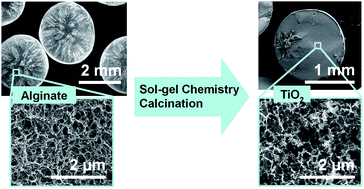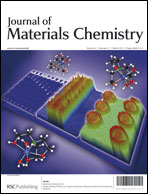Meso-macroporous millimetre-sized TiO2 beads were synthesized using sol–gel chemistry within preformed alginate beads. The alginate beads acted as sacrificial templates, responsible for providing the spherical shape and controling structural properties of the TiO2 matrix. The TiO2 properties were varied by altering the alginate bead synthesis conditions (concentration of the sodium alginate, NaAlg, and calcium ions, Ca2+, in the gelling bath) and the calcination temperature. The surface area of the TiO2 beads reached maxima using template beads prepared in a 0.27 M Ca2+ bath, for a given concentration of NaAlg. TiO2 (anatase) beads displayed high surface areas of 170 ± 10 m2 g−1 using a calcination treatment of 450 °C and samples calcined at 700 °C remained anatase with a decrease in surface area to 46 ± 1 m2 g−1. The post-functionalization of the TiO2 beads was studied using alendronate, an amino-bisphosphonate, with a maximum loading (30 ± 2 mg g−1) obtained at pH 2.01. The loading was highly dependent on surface area. These large (millimetre-sized) porous inorganic beads have potential in applications such as catalysis and adsorption-separation due to their ease of recovery and handling.

You have access to this article
 Please wait while we load your content...
Something went wrong. Try again?
Please wait while we load your content...
Something went wrong. Try again?


 Please wait while we load your content...
Please wait while we load your content...